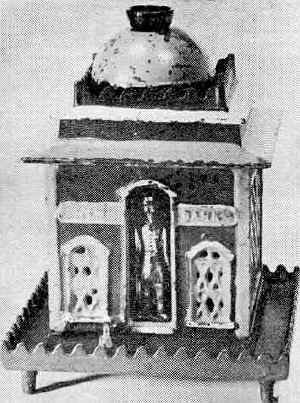New Bank
by F.H. Griffith - HOBBIES Magazine - September, 1966
 The designer, or possibly the manufacturer, of the mechanical bank
which is our choice as No. 149 in the numerical classification most likely felt that the
name ‘New’ would best describe what was felt to be a different or new type
mechanical bank. The writer has often pondered as to why this name was chosen and this
would seem to be the only logical explanation. After all, Guard Bank or Watchman Bank, in
either case, would be a much more appropriate or fitting name. Be that as it may, the New
Bank is a very attractive building type savings device, and while there is not much action
involved, it is completely appropriate as to the idea of protecting ones savings.
The designer, or possibly the manufacturer, of the mechanical bank
which is our choice as No. 149 in the numerical classification most likely felt that the
name ‘New’ would best describe what was felt to be a different or new type
mechanical bank. The writer has often pondered as to why this name was chosen and this
would seem to be the only logical explanation. After all, Guard Bank or Watchman Bank, in
either case, would be a much more appropriate or fitting name. Be that as it may, the New
Bank is a very attractive building type savings device, and while there is not much action
involved, it is completely appropriate as to the idea of protecting ones savings.
The New Bank is more or less a companion piece to the U.S. Bank (HOBBIES, January, 1958). The buildings are similar in appearance, the paint is the same type done in the same fashion, and the same brass metal stamping of the watchman or policeman is in the doorway of each. At the same time of writing the article on the U.S. Bank the writer had no information whatsoever as to the background of either bank. Since then he has been able to shed some light on the situation. There is a still bank known as the Metropolitan Bank, and this utilizes the same brass stamped figure as the U.S. and New Banks. The Metropolitan fortunately was covered by a design patent and there is no question but that all three were designed by the same individual. The design patent was issued to Anthony M. Smith of Brooklyn, New York, January 23, 1872. This covered a design for a toy safe wherein the watchman (this terminology for the brass figure was used in the original patent text) stood in a niche beside the safe door. He did not move and the patent was for a still bank. This fact is brought out since a few Metropolitan Banks have been converted to mechanicals in somewhat recent times, and, of course, these are simply fakes. The Metropolitan is a very nice still bank as such, and in its original state has a certain value. Why anyone would want to fake it into a mechanical seems somewhat beyond reason. It bears mention that in the altered version the figure moves slightly forward when the door of the safe is opened.
The New Bank shown is in fine original condition and painted as follows: The overall building is green with the inside of the bottom base section in dark blue. Brown edging is around the square foundation section. The front windows are red, as is the edging of the doorway and the sections which contain the name. The top and bottom of the door and windows are done in white, as is the name ‘New Bank’. The top cup-shaped part of the roof is black, the dome is red with a black line around the bottom, and then comes a section in blue. Below this is roofing in white, then a green band, and finally another roof section in red. The figure is a gold color and he is fastened to an inside section painted in blue. The operating lever with a red hand completes the coloring of a very bright, attractive bank.
The operation of the New Bank could hardly be more simple or appropriate. A lever is pressed to the operator’s left and in so doing the figure moves to the side and a coin slot appears in the open doorway. A coin is then deposited and on releasing the lever the figure snaps back into place as though guarding the deposit.
In closing, so that the writer does not receive letters from some individuals defending what they think to be a mechanical Metropolitan Bank, let this be said for the record. The writer knows who, when and where some Metropolitan Banks were converted to mechanicals. It is very obvious that threaded parts are not original and to date the writer has never seen a Metropolitan Bank in its complete original state in other than a still bank. It is extremely unlikely that it was ever originally made otherwise.
